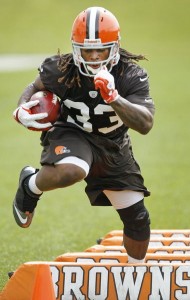In December, I noted that fewer rushing yards are coming from first round picks. That’s a trend that seems very likely to continue in 2014, and perhaps for the foreseeable future. As it turns out, running backs are also getting shorter and heavier.
LeSean McCoy, Alfred Morris, Frank Gore, Knowshon Moreno, Zac Stacy, DeAngelo Williams, Maurice Jones-Drew, Ray Rice, Giovani Bernard, Trent Richardson, Doug Martin, Danny Woodhead, and Mark Ingram are all 5’10 or shorter. As you can probably infer from the sheer quantity of the group, those players aren’t significant outliers: the “average” running back, weighted by rushing yards last season, was only five feet and 11.1 inches tall. That means backs like Jamaal Charles (6’1), Matt Forte (6’1), and Adrian Peterson are more outliers than the 5’10 backs.
This is a weighted average, so McCoy (who had about 3% of all rushing yards from running backs last year) counts three times as much as, say, Donald Brown when calculating the 2013 (weighted) average running back height. Regular readers will recognize that this is the same methodology I used when calculating the average (weighted) average of each team’s receivers last season. The graph below shows the average weighted height of all running backs since 1950:

As you can see, running back used to be a tall man’s position. But average running back height has steadily decreased, dropping 1.8 inches from 1965 to 2013. At the same time, running backs are getting heavier, although players at all positions are getting heavier. Still, I thought it would be useful to calculate an average weighted weight of running backs since 1950 using the same formula:

This trend towards shorter backs looks to continue in this year’s draft. Oregon’s De’Anthony Thomas (5’9, 174) is this year’s shifty/third down back model, while LSU’s Jeremy Hill (6’1, 233) and Ohio State’s Carlos Hyde (6’0, 230) fit the bruising back stereotype.
But most of the other top backs are in the short but stocky range: Auburn’s Tre Mason (207 pounds), Wisconsin’s James White (204), and combine superstar Jerick McKinnon (209) from Georgia Southern are all 5’9. Arizona’s Ka’Deem Carey and Washington’s Bishop Sankey are both 5’10 and around 208 pounds. Florida State’s Devonta Freeman (5-foot-8, 206 pounds) and Boston College’s Andre Williams (5’11, 230) also fit the general mold.
This makes sense to me, even if someone like Peterson remains the best back of our era. For running backs, a lower center of gravity helps, and as weight training and nutrition improves, packing on 210 pounds of muscle on a 5’10 frame is no longer atypical. Franco Harris, Jim Brown, and John Riggins were all 6’2, 230. Larry Csonka was even bigger. But the shorter back model is clearly preferred now.
One other note to keep in mind: Over the last decade, running backs are getting lighter. This is a pretty noticeable departure from historical trends, and I can’t imagine this feature is being duplicated at many other positions. But since lighter backs tend to be better in the passing game, this result isn’t too surprising, either.

